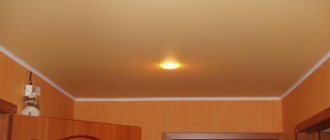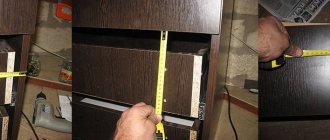Unfortunately, only after finishing the renovation in our new (or old) apartment, we understand that we should have started with completely different things, and that many mistakes could have been avoided “if only we knew...”.
But that’s why they are mistakes, to learn from them. True, it is not necessary to learn from your own: we study other people’s mistakes in repairs - and learn from them!
So, what mistakes do we make most often when renovating a kitchen?
- Floors. Wooden floors in the kitchen are always prone to dents from toys, falling lids, etc. Even if your children are super neat and the grasping reflex runs in your family, wood floors are still impractical. Today it is customary to lay laminate flooring in the kitchen, but usually the owners of such kitchens quickly become convinced that the decision made is wrong: the first leak (sink, refrigerator, etc.) - and the laminate swells.
- What about tiles? Tiles are a great solution for the kitchen! The main thing is not to make a mistake with color and texture. Dust and dirt are perfectly visible on dark tiles, and even wiping the floor every hour will not provide a feeling of cleanliness. And light tiles are too easily soiled. Also, you should not take tiles that are too smooth (slippery) or too textured/rough (they are extremely difficult to clean). The ideal option is a wide, matte tile with minimal relief and an optimal shade (so as not to stick out dirt and dust).
- Lighting. No need to skimp on light bulbs for the kitchen. There is always a lack of bright light in this room, so think in advance about how many light bulbs you need and in what places to “screw” them later. Be sure to pay attention to the area above the stove, the area above the dining table, and the area above the table where you actually cook (this area is the most important).
- Sockets. The main mistake of all new repairmen is saving on sockets. More precisely, the savings are small, but then the shortage of sockets is extremely acute. And it is in the kitchen that they will be missed most of all. Calculate exactly how many sockets you need based on your household appliances (existing and future). As a rule, the kitchen requires about 8 outlets (or even more) - a refrigerator and PMM, a microwave and a kettle, a coffee machine, etc. It is recommended to immediately make double sockets everywhere. And be sure to provide at least a couple of sockets above the worktop (right on the apron). When planning the number of sockets, also consider such a thing as a power reserve to service all devices.
- Protruding handles on furniture . Firstly, everyone will hit their knees (adults) and heads (children) against them. The kitchen owner will hit the handles on the upper cabinets. In addition, the more solid the handle, the smaller the opening angle of the door itself, and the more difficult it is to pull out the drawer.
- Ergonomics of space. Think carefully about the design of your kitchen in advance (!). It will be extremely difficult to redo the renovation once gas and water pipes have been installed, an apron and a hood have been made over the future stove. Consider the most important points: no labyrinths in the kitchen - it’s inconvenient! The main space should be free for quick easy movement, free opening of drawers, etc.
- Marble and other rough porous materials are not practical in the kitchen! Neither as a floor covering, nor for a countertop, nor for a sink. The porosity of the material ensures deep penetration of dirt and its difficult removal. It is better to choose artificial stone for the countertop.
- Facades . No gloss! Unless you have a lot of time to constantly scrub fingerprints off the gloss. Relief facades are also a headache. Scrubbing off dirt that has clogged up in the relief (especially white!) is difficult and time-consuming. White facades look chic, but over time the shade of the most frequently wiped areas on the furniture changes.
- Space for pots, lids, pans and household appliances . Immediately think through the cabinets in the lower part of the kitchen for all this beauty, so that later it does not fall on your head from the upper shelves.
- There should be no gaps between the stove (hob) and the countertop. Otherwise, everything you carry to the stove will spill onto the floor, and there will always be dirt on the floor between the stove and the cabinet.
- The apron is made only from fire-resistant materials! Wallpaper, even if very beautiful, must be protected with special glass. Leave the polypropylene finish for other rooms - it will simply melt. Choose materials for your apron that do not burn, do not melt, do not release poisons into the air when heated, and do not deteriorate from exposure to household chemicals.
- Backsplash tiles. The deeper and wider the seams, the more dirt they contain, which is difficult to wash out over the entire area above the kitchen work surface. White grout is another big mistake for beginners; it is difficult to clean, and dirt is clearly visible. The ideal option is absolutely smooth, not glossy and not too textured tiles with minimal seams.
- Washing. If you choose a sink that is too small, you will constantly see a mountain of dishes right on the table. A sink without a wing is a constant “sea” around the sink. It is convenient to place cups and other dishes that drain after washing on the sink wing.
- Walls. If you're going to hang heavy cabinets in your kitchen, make sure the walls can support them. Naturally, a plasterboard partition will not support such furniture - it needs to be strengthened in advance. It is recommended to immediately provide places throughout the apartment that may require additional reinforcement - under the TV, under shelves, etc.
- Do not place the stove next to the refrigerator! Even if there is not enough space, look for another option. Otherwise, your wonderful, fashionable refrigerator will have a long life in the shortest possible time.
The main mistakes when renovating an apartment
When you take on a serious renovation for the first time, you are likely to make a bunch of mistakes that will subsequently complicate your life, hit your budget and take up time for rework. However, you can avoid some mistakes. We'll cover the most common ones and how to get around them.
Plan the stages of repair work
Remember the most important thing - all actions must be completed in a timely manner.
After completing the rough finishing, all construction debris must be removed. Only after this can you begin finishing. In order not to stain the new parquet with paint, and not to tear the newly pasted wallpaper with tools, you must adhere to the work plan. It is advisable to start finishing from the farthest room, and do the work starting from the top and going down: first the ceiling, then the walls, and lastly the floor.
Think over the electrical wiring diagram
One of the most common shortcomings of a newly completed renovation is an insufficient number of outlets.
It is necessary to think in advance about how the rooms will look, how furniture and other interior elements will be located in them - this is what will make it possible to successfully plan the electrical wiring diagram. The shortage of electrical power sources is most severe in the kitchen. It is important to understand how many sockets you may need in the future. To do this, you need to calculate how many appliances you will use at the same time: TV, kettle, refrigerator, stove, exhaust hood, plus add 3-4 more sockets to this number.
Think about how you will store things
Lack of storage space is a common flaw in a newly renovated apartment.
Of course, you can put several bulky cabinets and chests of drawers where you can put everything you need. However, the living space in such an apartment will be significantly less. An excellent solution to this issue is a built-in wardrobe or dressing room. You can make a lot of shelves, racks and all sorts of structures for placing clothes and other things in them. You can make a built-in corner dressing room in the hallway, or allocate part of the bedroom for this idea, having previously calculated the area of the sleeping area and made sure that the size of the room allows this.
Many apartments from ENKO Group have niches for wardrobes and functional rooms for dressing rooms. This is very convenient and allows residents to save useful space at home and comfortably store their belongings even in small apartments.
Another way to avoid clutter in your living space and organize storage space is to create a “podium” under the bed. This design is best suited for storing laundry.
Separately, you should think about the placement of household items, unless you want to make a vacuum cleaner or ironing board part of your interior. A separate storage room is best for such things, but this is not possible in every apartment. In this case, built-in modules for storing household items will come to the rescue.
How to save on repairs without consequences
Repair is a very expensive undertaking, so many people try to save money on it.
It's important to do this wisely. First of all, it is not recommended to save on rough work (walls, floors and ceilings), as well as on basic utilities and structures. We are talking about electrical wiring and pipes, as well as window units, doors and plumbing. If the pipes break and the electrical wiring goes down, then all the repairs you have made may be ruined. To eliminate the malfunction, you will have to tear off the wallpaper and suspended ceiling, ditch the walls, knock off the tiles, etc. And if windows and doors allow air to pass through, this will lead to drafts and dampness, which will certainly affect the finishing materials.
Ceramic tiles are also not the best choice for saving money. Cheap models, as a rule, are of poor quality, and after some time they become covered with cracks and come off the screed. In addition, cheap models suffer from the fact that the same batch may contain tiles with a deformed texture and a different shade. It is best to buy high-quality tiles that are more expensive so that they serve faithfully for many years.
By the way, if you decide to save on something, be prepared for the fact that it may suddenly fail or give a different result than you expected. So, cheap radiators can leak or become stained, cheap faucets can break, cheap laminate flooring can swell from spilled water, and the list goes on.
The most reliable way to make economical and high-quality repairs in a new apartment is to order it from a trusted developer. ENKO Group of Companies offers new residents to make repairs at a competitive price from 7,000 rubles/m2. Renovated apartments from ENKO Group of Companies are ready for occupancy. The list of works includes complex finishing of walls, floors, ceilings, installation of windows and doors, laying laminate flooring, installation of low-current networks and suspended ceilings, and more. Read more about what high-quality and inexpensive repairs should look like here.
Do you want to design an apartment yourself? Our material “Is it possible to make an interior design project for an apartment on your own?” will help you with this.
One-liner advice from those who have experienced renovations
We interviewed several people who recently completed renovations in their apartment, and this is what they said.
Egor Alekseevich, 46 years old:
You need to make as many spotlights as possible in the rooms. One chandelier will definitely not provide enough light.
Next time I will definitely install heated floors throughout the apartment. Surprisingly, your feet are colder not even in winter, but in spring and autumn.
The walls need to be properly leveled if you are going to install built-in furniture.
Elena, 31 years old:
There will never be any more carpet in my apartment!
Open shelves with books, figurines and other nonsense are a terrible dust collector!
I find it very difficult to cope without a heated towel rail!
Now I wouldn’t spare money on a designer to immediately make everything good and beautiful.
Stanislav, 24 years old:
Just one outlet in the bathroom is not enough. My wife demands to add a few more, but I can only offer her a surge protector with three inputs.
It would be nice to have a wide cable channel in the apartment so that there is an entrance for all possible cables.
Just in case, light and socket for the loggia.
It was necessary to record the location of electrical wiring throughout the apartment in order to know in which places it was impossible to drill into the walls.
Adil, 35 years old:
I chose the wrong door with a large glass insert. When a child falls asleep, the light from the corridor disturbs him.
I didn’t even think about how the door handle, when you open the door, will rest against the switch in the corridor.
It was necessary to make curbs in the place where the bathtub meets the tiles, but we simply sealed it with silicone sealant. Now after a shower there is always water in the corners.
White grout for ceramic tiles is stupid! It becomes dirty almost immediately and looks terrible.
So, renovating rooms - living room, bedroom, children's room - what mistakes to avoid?
- Don't leave the old wiring behind. If it was made during the reign of Tsar Gorokh, do not spare money for a new one. So as not to later open the repaired walls in search of an area with a short circuit. It is important to note that in old apartments, where there has been no renovation since Soviet times, the wiring can run in a completely unpredictable way, even diagonally. That is, when hanging a shelf, you may accidentally hit the wires with a puncher. Only new wiring will help you avoid problems - done according to all the rules, by professionals, and marked on the drawings, which you will then use to guide yourself. Important! First, carefully think through the plan for arranging the furniture, so that later you suddenly don’t find that there is not a single socket near the bed, not one at the desk, and as many as five behind the closet.
- Shield and individual machines. When making electrical wiring, install a machine in each room (plus it is recommended separately for the boiler and washing machine). Firstly, you will know exactly which room caused the plug to break due to overvoltage, and secondly, you will not have to turn off the power to the entire apartment if any electrical work is necessary.
- Warm floor. All “victims” of renovations begin to regret the lack of heated floors with the arrival of autumn. Even in the southern regions. Warm floors won’t cost you a lot of money and energy, but the whole family will thank you from morning to evening, calmly plopping barefoot even on the tiles in the bathroom. Install heated floors wherever you walk barefoot. Naturally, with a timer.
- If children are growing up in the family, install switches at the required height so that the children can cope with this function themselves.
- If you don’t have “closets” (Soviet closets) and your own veranda and shed, and you don’t even have a loggia where you can put everything unnecessary, then think about a place in the apartment for things that require storage - suitcases and vacuum cleaners, sleds and strollers, New Year’s Christmas trees with toys, etc. All this needs to be stored somewhere. Where? Stock up ahead of time!
- Soundproofing. If your house is not of the Stalinist type - with thick walls - start with soundproofing. Otherwise, later you will greatly regret listening from two sides (or even three) every evening to concerts of neighboring teenage musicians, young children and depressed adults. Use special materials (fortunately, there are no shortcomings in them today) that have similar characteristics. If you have children and dogs living with you, and your housewives love to click their heels around the apartment, then think about your neighbors downstairs too - do soundproofing before installing the floors.
- Flooring. Carpet is a warm and pleasant covering for feet. But it creates a lot of dust, it is impossible to wash it, it gets dirty quickly, and it can cause allergies. If you don’t have a special cleaning vacuum cleaner with steam treatment and a lot of free time, choose other coatings. Cork flooring is pleasant, environmentally friendly, natural, and is not afraid of moisture. The downside is that there are traces of furniture on the cork and, in general, cork is absolutely not practical for rooms where life is in full swing. What flooring to choose for a children's room?
- Forgetting to make an additional switch near the bed , you doom yourself to get out of your warm bed every evening to turn off the light. By the way, don't forget to install the switch at the door in the right place. So that when you enter a room, you can immediately feel it with your hand.
- Big beautiful chandeliers are great! But it is much more convenient (in practice) when you have several light sources in the room - a bright chandelier, spotlights, several sconces and a floor lamp, table lamps.
- Do not hang heavy cabinets or shelves on your bed. Of course, the master can fix the shelves “tightly”, and you will only place “light” objects on it. But, as a rule, sooner or later something falls on your head. And it’s good if it’s a teddy bear, and not a stack of books or the shelf itself.
Combining rooms
Combination of bath and toilet.
After the remodel, more than 50% of people claim that this was the MAIN mistake in renovating an apartment that does not have a duplicate bathroom. This is impractical if more than one person lives in the apartment.
Kitchen and living room
The combination of kitchen and living room should also be justified. To preserve the family hearth, leave the household some free space; we recommend combining the kitchen and living room only if there are other rooms with tightly closing doors.
Video: Mistakes made when renovating bathrooms and toilets
- And again the sockets. It would seem – why in the bathroom! Can I throw in an extension cord? No extension cords in the bathroom - it's dangerous! Install the sockets in advance (and with covers against moisture!), so that later you don’t have to pierce the walls directly over the new tiles. Immediately think about sockets for a hair dryer, washing machine, electric heated towel rail (if you don’t have a classic one) and other needs.
- Do not combine a bathtub and a toilet if space allows you not to do so.
- Lack of waterproofing can cost you a pretty penny if your washing machine suddenly breaks down or you forget to turn off the tap in the bathroom. Don't skimp on waterproofing!
- Do not lay glossy, slippery tiles in the bathroom - this is dangerous . Black tiles (and dark shades in general) for the bathroom are a big mistake. On black tiles (and earthenware!) all the stains, stains, dust, and dirt are visible.
- Choose expensive plumbing fixtures right away . Then it will be very disappointing when the toilet becomes covered with small cracks and the acrylic bathtub turns yellow.
- Forced exhaust . Even if you have a dry and warm apartment, forced exhaust (which will turn on along with the light in the bathroom and toilet) in the bathroom is protection against mold and odors.
- Pipe routing . Trust the work only to a master! In addition to the fact that the pipe layout in the bathroom must be of high quality, you need to take into account both the angle of inclination and high-quality drainage.
- Do not block access to communications! This is the most common mistake during repairs. Leave beautiful (and large!) plastic windows, which in case of an “accident” will provide access under the bathtub, to taps and pipes.
- One lamp in the bathroom will not be enough - add additional light near the mirror, but taking into account protection from moisture.
- Stretch ceilings will save you from a neighbor's flood. Suspended ceilings in the bathroom are a waste of money.
Apartment redevelopment
If you are going to demolish walls, even with independent repairs, you need a project in which the little things will be spelled out - the volume of demolished and erected walls with all dimensions and references.
Measure twice, cut once, don’t tear down walls without a plan
Before redevelopment, the project must be approved by the district design and inventory bureau. Collecting documents will take from a week to three months. Only after approval can redevelopment be done.
We recommend trusting a professional to avoid mistakes during repairs. If you touch important structures, you may get a fine and the walls will have to be returned to their place.










